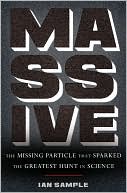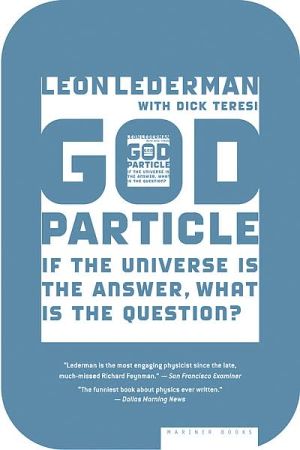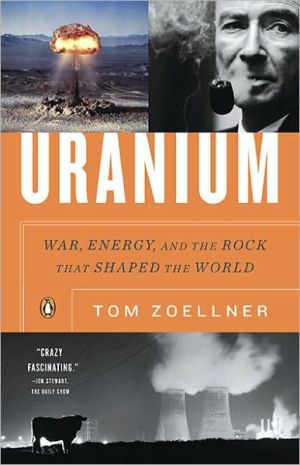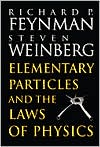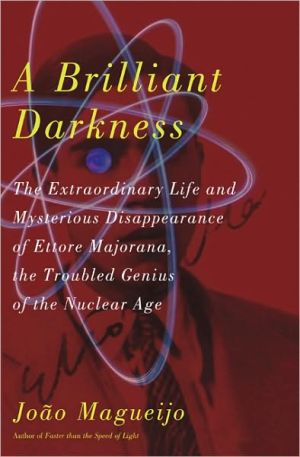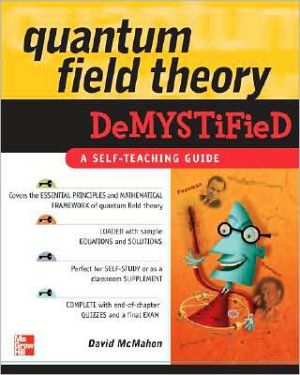The Mystery of the Missing Antimatter
In the first fractions of a second after the Big Bang lingers a question at the heart of our very existence: why does the universe contain matter but almost no antimatter? The laws of physics tell us that equal amounts of matter and antimatter were produced in the early universe—but then, something odd happened. Matter won out over antimatter; had it not, the universe today would be dark and barren.\ But how and when did this occur? Helen Quinn and Yossi Nir guide readers into the very heart...
Search in google:
"I just had the great pleasure of reading Quinn and Nir's new book, The Mystery of the Missing Antimatter. The book reads like an exciting real-life mystery—and even the appendix offers a fascinating bit of scientific history. It tells a very compelling story in a very accessible manner, and I predict it will get the large and thoughtful readership it deserves."—Harold T. Shapiro, president emeritus and professor of economics and public affairs at Princeton University"This is a most remarkable book from many points of view. Using the matter-antimatter asymmetry in the universe as a central theme, it tracks the reasoning behind the essential ideas comprising the standard model of particle physics, its shortcomings, and its impact on our knowledge of the cosmos. And it does all this without a single equation, not even a Greek letter. This asymmetry accounts for our very existence, and Quinn and Nir have been in the thick of the theoretical developments. This is indeed heady stuff."—Val L. Fitch, Princeton University"Quinn and Nir bring to light one of the deepest mysteries of science and make a compelling case that its resolution will profoundly impact our understanding of the laws that govern the universe."—Paul Steinhardt, Princeton University"Addressing the scientific version of the question of why there is something rather than nothing, Quinn and Nir take the reader on a fascinating journey through the story of particle physics and cosmology."—David Gross, director of the Kavli Institute for Theoretical Physics"The aim of this book is to use one of the most fundamental questions facing physicists today—why the observable universe contains a quantifiable asymmetry between the amount of matter and antimatter—to take readers on a tour of a host of important concepts in modern particle physics and cosmology. Helen Quinn and Yossi Nir have impeccable particle-physics credentials, and their book is a timely and informative contribution."—Mark Trodden, Syracuse University"This book deals with one of the most fundamental mysteries of nature. Perhaps it is fitting that the authors have taken a very ambitious approach to writing about it: they cover just about every aspect of modern particle physics. This book will appeal to a serious reader whose curiosity will be rewarded by a wealth of ideas and history related to the subject of matter-antimatter asymmetry."—Alexander Kusenko, University of California, Los Angeles Marcus Chown - BBC Focus Magazine [A] remarkable book which provides one of the most satisfying tours of particle physics I have ever read.
The Mystery of the Missing Antimatter \ \ By Helen R. Quinn Yossi Nir \ Princeton University Press \ Copyright © 2007 Princeton University Press\ All right reserved.\ ISBN: 978-0-691-13309-6 \ \ \ \ \ Chapter One \ PRELUDE: THE MYSTERY OF THE MISSING ANTIMATTER \ In the beginning-what was the beginning? Every culture asks this question. Traditionally each finds some answer, a creation myth, a cosmology. These stories satisfy an innate human longing to know about our origins. Only recently has our scientific understanding of the history of the Universe progressed to the point that we can begin to formulate a scientifically based answer-a scientific cosmology. We know that the Universe is evolving and we understand many facets of its history. We know its age, about fourteen billion years! We can ask, and often even answer, detailed questions about the very earliest times, times immediately after the Big Bang. We can test our ideas by comparing detailed observation of the Universe to detailed simulation of its evolution built on our modern understanding of physics. Today our technology for probing physics on both the tiniest and the largest imaginable scales can take us closer to the beginning of the known Universe than ever before. Much has been learned. Big questions remain; each new answer reveals new questions. What a wondrous time this is for cosmology.\ Our story centers on a question that links cosmology and particle physics. Experiments in high energy physics laboratories have demonstrated that, in addition to the stuff we call matter, there is another set of stuff. It is just like matter except with a reversal of charges. It interacts, with itself and with matter, in ways that we understand. Physicists call this stuff antimatter. We make it and study it in our laboratories, but find very little of it in nature. The laws of physics for antimatter are almost an exact mirror of those for matter. That makes the imbalance between matter and antimatter in the Universe a deep mystery. This mystery is the central topic of our book.\ For each type of matter particle there is a matching type of antimatter particle. Given the right conditions, we can convert energy from radiation into a matched pair of newly formed matter and antimatter particles; that is how we produce antimatter in our laboratory experiments. Conversely, whenever an antimatter particle meets its matching matter twin they can both disappear, converting all their energy into a flash of radiation. Thus any antimatter particles produced in the laboratory, or in naturally occurring high energy processes, disappear again very shortly. In a matter-dominated environment their chances for longevity are very slim!\ In probing the Universe today, experiments from the ground or on satellites can achieve sensitivity to times long before any structure and form evolved within it. They observe radiation that has been traveling through space for a very long time, almost as long as the Universe has existed. We can use these observations to find out about the Universe at the time this radiation began its journey. We can explore even earlier stages by modeling them according to our theories and asking whether the model can match the Universe as we observe it. The observations show a Universe that is expanding, and therefore it is cooling, and becoming, on average, less densely populated by particles.\ Our theories suggest that, at very early times in the development of this evolving Universe, matter and antimatter, all possible types of particles and antiparticles, existed equally in a hot, dense, and very uniform plasma. If equal amounts of matter and antimatter had persisted, then today the Universe would be a very dull place. At the early high temperatures, creation and annihilation of energetic matter and antimatter particles would have served not only to keep their numbers equal, but also to keep those numbers large. However, as the Universe expanded and cooled, it reached a stage where annihilation could still occur whenever a particle met an antiparticle, but the reverse process, creation of a particle and an antiparticle, became more and more rare. There was essentially no radiation remaining with sufficiently high energy to cause it. Gradually all the particles and antiparticles would have disappeared. The Universe would have no visible objects in it.\ Today, however, we do see a universe with huge structures made of matter: earth, solar system, galaxies, clusters of galaxies; all matter, with very little antimatter, governed on large scales chiefly by gravitational effects. All these visible parts of the structure, the stars and galaxies that light up the heavens with many forms of electromagnetic radiation, from radio waves to gamma rays (including, of course, their beautiful visible light), would not exist today if somehow matter had not won out over antimatter at some very early time in the evolution of the Universe.\ How and when did the histories of matter and antimatter take such different courses? This is one of the great mysteries of science today. A question at the root of our very existence, it is one for which, as yet, science has no clear answer. Our purpose in this book is to discuss the issues around this question, explaining what we physicists do and do not understand at present, and how we hope to learn more.\ We can describe the history of the very early Universe with some confidence for events that occurred from a millionth of a millionth of a second ([10.sup.-12] seconds) after the Big Bang. The reason is that in our high energy laboratories we can produce particles with energies similar to those that prevailed in the Universe at those times. We know how particles behave under those conditions. Thus, for example, the wisdom of nuclear physics allows us to model the primordial production of small nuclei from collisions starting with protons and neutrons, long before stars began to form. Because we know very well what energies are required for collisions to take apart each of the light elements into its constituents, protons and neutrons, we can identify rather precisely the time at which the Universe became cold enough that this destruction practically ceased, and thus production of elements started in earnest. This was about three minutes after the Big Bang. The success of our model of the early Universe in predicting the relative amounts of deuterium, helium, tritium, and lithium produced in this primordial nucleosynthesis is one of the great triumphs of cosmology.\ For earlier events, back to as early as [10.sup.-40] seconds (a ten-billionth of a ten-billionth of a ten-billionth of a ten-billionth of a second-an unimaginably small time!) after the Big Bang, the conditions were considerably more extreme than anything that we can create in our laboratories. But, amazingly, our theoretical understanding of particle physics can be used to develop a reasonable (even if hypothetical) picture of events that happened at such early times, when the Universe was hot and dense beyond imagination. Our picture may not be completely right, but it builds on what we do know and tells us what issues it is critical to study further.\ For yet earlier times, before about [10.sup.-40] seconds after the Big Bang, we do not even have any theory we can use; we run into contradictions if we try to apply our best current knowledge to such extreme conditions. At this time the Universe was an unimaginably hot and dense plasma of particles, interacting rapidly and energetically. The best we can do is start a moment after the Big Bang, immediately after the first rapid stage of Universal expansion (known as inflation), and follow the history of the Universe forward from then. Questions about how the Big Bang began, or what, if anything, was there before it, fascinating as they are to speculate about, cannot be addressed with any certainty at the current stage of our understanding, though they are an active topic of current work.\ This much we do know: The fate of antimatter to disappear was sealed by the time the Universe was no older than a millionth of a second. At that time, matter particles and antiparticles were both still very abundant, but there must have been a tiny edge for particles over antiparticles, about one extra particle for every ten billion particle-antiparticle pairs. This tiny excess is all that matter needed for a total victory over antimatter in the present Universe. All the visible structures in the Universe that we observe today-planets, stars, galaxies, clusters of galaxies-are made from that surplus of particles over antiparticles. While we know for sure that the tiny excess of matter over antimatter existed when the Universe was a millionth of a second old, it is very likely that the crucial events that created this excess happened well before, sometime between [10.sup.-40] and [10.sup.-12] seconds, the period that is accessible to our theories but not to experiments. This makes the mystery of the missing antimatter a very exciting one: it gives us a window into extremely early times, and tests our particle physics theories under conditions that we cannot recreate in our experiments.\ Matter and antimatter obey very similar but not quite identical physical laws. We know that a tiny difference between the laws of nature for matter and antimatter exists because we have seen it in experiments. It is now incorporated into our theories of particle physics. We can use these theories to develop a picture of how and when an imbalance of matter and antimatter could develop. We can even calculate how big the imbalance should be. That calculation makes predictions for conditions we can observe today, for the amount of matter in stars and galaxies compared to the amount of radiation in the background microwave signal that we see from all directions in space.\ But the mystery of the missing antimatter is not solved! Our modeling tells us that the present theory of elementary particles and their interactions, the so-called Standard Model, which matches correctly the results of numerous laboratory experiments, must be flawed or incomplete. For, if it were the full story, the disappearing antimatter would have taken along with it too much of the matter; too few protons and neutrons would persist to make just a single galaxy, such as our own Milky Way. So this is the mystery of the missing antimatter in its modern variation: What laws of nature, not yet manifest in experiments and not part of our current Standard Model, were active in the early Universe, allowing the observed amount of matter to persist while all antimatter disappeared from the Universe?\ The question of the imbalance between matter and antimatter focuses our attention on a particular early stage in the history of the Universe. Much has recently been learned about other episodes. Beautiful experiments have tested and refined our understanding of the big picture of how the Universe developed and is still developing. Along the way these experiments tell us there are two more mysteries to solve.\ One is the mystery of the dark matter, stuff that is neither matter nor antimatter but some as yet unknown type of particle. This mysterious dark matter is also essential in the history of the Universe, but it interacts so little that it does not form stars or produce any visible emanations. We know that dark matter exists because we observe its gravitational effects. All our modeling of the motions of stars within galaxies, of the patterns of multiple images of the same distant galaxy formed by gravitational lensing as the light paths are bent by the mass of nearer galaxies, and of the evolution of structure in the Universe cannot be made to work (that, is to match the observations) without it. There is roughly six times as much mass in dark matter particles today as there is in matter particles. We cannot at present specify further what the dark matter is. All we know is that it has mass and interacts very little with itself or with matter and antimatter, except via gravitation. It is most likely some kind of particle, but we do not know enough about it yet to say what kind.\ The third mystery is the most recently discovered, and hence, as yet, the least understood. The rate of expansion of the Universe is not slowing down, as we expected it should. Instead, it is accelerating. Whatever causes this is not yet part of our particle theories at all, though very speculative extensions suggest ways it might be added. This effect is generally called dark energy. The mysteries of dark matter and dark energy are both exciting and still developing detective stories. We will tell you what little we know about them too, though our stress in this book is on the matter-antimatter puzzle.\ To develop the story of matter and antimatter in the Universe we will develop a number of themes; the Universe itself is of course one of them, along with the story of matter and antimatter. But we will also need to develop the themes of symmetries and of energy before we can tell our story in a meaningful way. Then too the theme of experiments, of how we know what we claim to know, must enter the story. We hope you will find the development of each of themes interesting in its own right; they are the basics of modern particle physics, and to understand the Universe we must understand them all.\ Chapter Two\ CONSTANT PHYSICS IN AN EVOLVING UNIVERSE\ Universal Laws\ You cannot begin to do physics, or any form of science for that matter, without making one fundamental assumption. All science is based on it. We must assume that there are underlying laws of nature that are the same whenever and wherever we look at the world. Without this assumption there would be no predictive power to science. Whatever we might decipher of the laws of nature today in our laboratory would not be useful to predict what would happen tomorrow or in any other place. If the physical laws are independent of place and time they are universal; the laws that govern the behavior of everything in the Universe are those we can learn by experiments in any laboratory.\ Of course, the laws of physics, while universal, do not say that everything is always the same. What happens in any place and time depends not only on the laws of physics but also on the physical conditions in that place at that time. The observed properties of a system of particles at very high temperature and density can be quite different from those of a dilute cold system, even though both are governed by the same underlying physical laws.\ In the early days of science, the idea that the laws of science are immutable was somehow tied up with ideas about the immutability of the Universe itself. At least in the Western world, it was generally assumed that we live in a Universe that, in some overall sense, is static and unchanging, though incorporating the repeating cycles of Earth's rotation and planetary motions within that overall constancy. When Albert\ Einstein (1879-1955; Nobel Prize 1921) saw that his equations for general relativity (which is the name for his theory of gravity) would typically describe a Universe that evolved, he found a way to patch the theory up, adding a parameter or quantity called the cosmological constant. This could be chosen to ensure a static Universe. But we have to look at the Universe itself to decide if this solution, or one in which the Universe evolves, is the one that nature has chosen for us to live in.\ The idea that the Universe itself indeed does evolve began to take shape about the same time as the idea of antimatter first appeared. These two stories, that of matter and antimatter and that of the Universe's evolution, seemed at the time to be quite unconnected. But eventually, since the Universe must work by the same physical laws as we find in our laboratory, the two stories come together in interesting ways. As we go through this book we will not follow these stories in exactly chronological order, as that would interweave the threads of the various ideas in too complicated a fashion. However, at the end of the book we provide a brief chronology so you can keep track of what happened when.\ Hubble and the Expanding Universe\ The astronomer Edwin Hubble (1889-1953) was one of the first scientists to recognize that the possibility of an evolving Universe should be considered seriously. Indeed he found evidence to support it. Hubble was a brilliant man, who followed his undergraduate degree in mathematics and astronomy with a term as a Rhodes Scholar where he earned a legal degree and went on to pass the bar in Kentucky. His father apparently thought law a more respectable profession than astronomy. But eventually he returned to his original interest and completed a Ph.D. in astronomy. After World War I was over, he took up a position at the Mount Wilson Observatory from where he made enormous contributions to science.\ (Continues...)\ \ \ \ \ Excerpted from The Mystery of the Missing Antimatter by Helen R. Quinn Yossi Nir Copyright © 2007 by Princeton University Press. Excerpted by permission.\ All rights reserved. No part of this excerpt may be reproduced or reprinted without permission in writing from the publisher.\ Excerpts are provided by Dial-A-Book Inc. solely for the personal use of visitors to this web site. \ \
Acknowledgments xiChapter 1: Prelude: The Mystery of the Missing Antimatter 1Chapter 2: Constant Physics in an Evolving Universe 7 Universal Laws 7 Hubble and the Expanding Universe 8 Red-shifts: Evidence for an Expanding Universe 12 Numbers Large and Small 17 What Do We Mean by "Universe"? 19Chapter 3: As the Universe Expands 21 Running the Clock Forward: Radiation 21 Running the Clock Forward: Dark Matter 26 Running the Clock Forward: Light Nuclei 29 Running the Clock Forward: Matter and Antimatter 32Chapter 4: What Is Antimatter? 36 What Is Matter? 36 Dirac Introduces Antimatter 42 Experiments Confirm That Antimatter Exists 45 Radioactive Decays of Nuclei 48Chapter 5: Enter Neutrinos 51 Pauli: The Beta Decay Puzzle 51 Fermi: The Theory of Neutrinos Develops 53 Cowan and Reines: Neutrinos Detected 55Chapter 6: Mesons 57 Yukawa and the Pi-Meson 57 Strange Mesons, Strange Quantum Concepts 61Chapter 7: Through the Looking Glass 63 What Physicists Mean by the Term Symmetry 63 A Gedanken Experiment 64 The Actual Experiment 67Chapter 8: Through the Looking Antiglass 73 Another Gedanken Experiment 73 Cronin and Fitch: Matter and Antimatter Do Not Follow the Same Laws 75Chapter 9: The Survival of Matter 80 Pauli's Other Letter: Initial Conditions on the Universe 80 Sakharov: The Conditions Needed to Develop an Imbalance 84 Cosmology with Sakharov's Conditions Met: Baryogenesis 88Chapter 10: Enter Quarks 91 Quarks 91 Why Don't We See the Quarks? 96 What about Dark Matter? 100 The Missing Charm, the Surprising Tau 101 The Standard Model: Particles and Interactions 107Chapter 11: Energy Rules 111 Stored Energy, Forces, and Energy Conservation 111 Force Fields Permeating Space 114 Field Theory and the Energy Function 116Chapter 12: Symmetry Rules 121 Symmetries as Answers to the Question "Why?" 121 Symmetries and Conservation Laws 123 Space-Time Symmetries 124 Gauge Symmetries 126 Discrete Symmetries 128 Baryon and Lepton Number Conservation? 130Chapter 13: Standard Model Gauge Symmetries 132 The Symmetry behind the Electromagnetic Interaction 132 The Symmetry behind the Strong Interaction 134 The Symmetry behind the Weak Interaction 137Chapter 14: A Missing Piece 140 The Puzzle of Particle Masses 140 How Do We Describe Nothing? 146 At Last, CP Violated in the Standard Model 153Chapter 15: It Still Doesn't Work! 159 Running the Clock Forward: The Standard Model 159 Now What? 163Chapter 16: Tools of the Trade 168 Accelerators 168 Detectors 172 Data Handling and Analysis 177 How Projects Develop 178Chapter 17: Searching for Clues 180 Where Are We Now? 180 Testing the Standard Model in B-Meson Decays 182 Oddone: How to Build B Factories? 184 Running the B Factories: The First Test 190Chapter 18: Speculations 194 Why Are We Never Satisfied? 194 Grand Unified Theories 195 Supersymmetry 201 Way beyond the Standard Model 204Chapter 19: Neutrino Surprises 206 Davis, Bahcall, Koshiba: Solar Neutrinos 206 Quantum Neutrino Properties 214Chapter 20: Following the New Clues 222 Some Things We Know 222 Some Things We Speculate About 225 Fitting It All Together 227Chapter 21: Finale 231 Appendix: A Timeline of Particle Physics and Cosmology 233 Perspective 233 Relevant Nineteenth-Century Developments 234 1900-1930: Development of Quantum Ideas, Beginnings of Scientific Cosmology 238 1930-1950: New Particles, New Ideas 245 1930-1960s: The Advent of Accelerator Experiments—The Particle Explosion; Implications of Expanding Universe Explored 249 1964-1973: Formulation of the Modern View of Particles and the Universe 256 Two Standard Models Emerge—Particles and Cosmology 263Index 273
\ ChoiceTwo distinguished physicists, Quinn and Nir trace in some detail both the history of modern particle physics and its relation to cosmology. Even though the text is free from equations, the authors clearly explain the details of the theories presented and their development. The logic and the meaning of the connections among the ideas make it interesting and challenging?.This is a fine book that belongs in college libraries.\ \ \ \ \ Times Higher Education\ - Frank Close\ The big mystery about antimatter, as far as scientists are concerned, is why there isn't more of it in the universe. This is a serious and well-researched exposition of particle physics and cosmology that shows how science came upon antimatter and is now trying to understand the asymmetry between matter and antimatter. A nice feature is the occasional inclusion of personal recollections of the development of the standard model and of the scientists involved, which adds charm to the narrative. [O]ne of the best overviews...essential reading for students of physics who want to know what research in theoretical particle physics is doing.\ \ \ Natural History\ - Laurence A. Marschall\ Quinn and Nir have a daunting task explaining . . . one of the most active areas of theoretical physics today. If you like reading cosmologist Steven Hawking's A Brief History of Time, or particle physicist Brian Greene's The Elegant Universe, you will find The Mystery of the Missing Antimatter an absorbing scientific whodunit.\ \ \ \ \ Booklist\ - Gilbert Taylor\ The standard model of particle physics is Quinn and Nir's arena for discussing one of its inadequacies: it has yet to answer why in the trillionths of a second after the big bang, there was a tiny numerical superiority of matter over antimatter; if there was not, atoms would not have formed. Addressing nonscientists, the authors describe the nature of this intriguing problem...[This book] will challenge yet reward readers with understanding of a fascinating subject at the frontier of science.\ \ \ \ \ ForeWord Magazine\ - Joe Mielke\ [For] anyone wanting to know how physics works and physicists think, the writers have made a difficult topic comprehensible as well as compelling.\ \ \ \ \ BBC Focus Magazine\ - Marcus Chown\ [A] remarkable book which provides one of the most satisfying tours of particle physics I have ever read.\ \ \ \ \ Space Review\ - Jeff Foust\ For those curious about why the universe is the way it is, this book is a reminder of how much we have learned about physics at its smallest and largest scales, but also how much more we have yet to understand.\ \ \ \ \ L. Schick\ Two distinguished physicists, Quinn and Nir trace in some detail both the history of modern particle physics and its relation to cosmology. Even though the text is free from equations, the authors clearly explain the details of the theories presented and their development. The logic and the meaning of the connections among the ideas make it interesting and challenging.This is a fine book that belongs in college libraries.\ \ \ \ \ Times Higher EducationThe big mystery about antimatter, as far as scientists are concerned, is why there isn't more of it in the universe. This is a serious and well-researched exposition of particle physics and cosmology that shows how science came upon antimatter and is now trying to understand the asymmetry between matter and antimatter. A nice feature is the occasional inclusion of personal recollections of the development of the standard model and of the scientists involved, which adds charm to the narrative. [O]ne of the best overviews...essential reading for students of physics who want to know what research in theoretical particle physics is doing.\ — Frank Close\ \ \ \ \ Natural HistoryQuinn and Nir have a daunting task explaining . . . one of the most active areas of theoretical physics today. If you like reading cosmologist Steven Hawking's A Brief History of Time, or particle physicist Brian Greene's The Elegant Universe, you will find The Mystery of the Missing Antimatter an absorbing scientific whodunit.\ — Laurence A. Marschall\ \ \ \ \ BooklistThe standard model of particle physics is Quinn and Nir's arena for discussing one of its inadequacies: it has yet to answer why in the trillionths of a second after the big bang, there was a tiny numerical superiority of matter over antimatter; if there was not, atoms would not have formed. Addressing nonscientists, the authors describe the nature of this intriguing problem...[This book] will challenge yet reward readers with understanding of a fascinating subject at the frontier of science.\ — Gilbert Taylor\ \ \ \ \ ForeWord Magazine[For] anyone wanting to know how physics works and physicists think, the writers have made a difficult topic comprehensible as well as compelling.\ — Joe Mielke\ \ \ \ \ BBC Focus Magazine[A] remarkable book which provides one of the most satisfying tours of particle physics I have ever read.\ — Marcus Chown\ \ \ \ \ Science NewsIn this page-turner, true science is written in the thrilling tone of science fiction. Quinn and Nir present the history of the antimatter problem and discuss its impact on our understanding of the cosmos—all without introducing a single equation or even a Greek letter. They reveal tantalizing possibilities for solving this puzzle, made possible by high-precision experiments that particle physicists like Quinn and Nir themselves undertake. For anyone wanting to know how physics works and physicists think, the writers make one of the greatest unsolved problems in physics both comprehensive and compelling.\ \ \ \ \ Space ReviewFor those curious about why the universe is the way it is, this book is a reminder of how much we have learned about physics at its smallest and largest scales, but also how much more we have yet to understand.\ — Jeff Foust\ \ \ \ \ Universe TodayWith the theme of a murder mystery installed in the reader by a silhouette on the cover, this book takes the reader on a tour de force of the case at hand. This book takes the reader on breathtaking foray into the depths of the particle that make-up our body and our worlds. And like an affable Dr. Watson, the reader can journey with [Helen Quinn and Yossi Nir] as they explore this still unsolved case.\ \ \ \ \ ChoiceTwo distinguished physicists, Quinn and Nir trace in some detail both the history of modern particle physics and its relation to cosmology. Even though the text is free from equations, the authors clearly explain the details of the theories presented and their development. The logic and the meaning of the connections among the ideas make it interesting and challenging�.This is a fine book that belongs in college libraries.\ \ \ \ \ BooklistThe standard model of particle physics is Quinn and Nir's arena for discussing one of its inadequacies: it has yet to answer why in the trillionths of a second after the big bang, there was a tiny numerical superiority of matter over antimatter; if there was not, atoms would not have formed. Addressing nonscientists, the authors describe the nature of this intriguing problem...[This book] will challenge yet reward readers with understanding of a fascinating subject at the frontier of science.\ — Gilbert Taylor\ \

